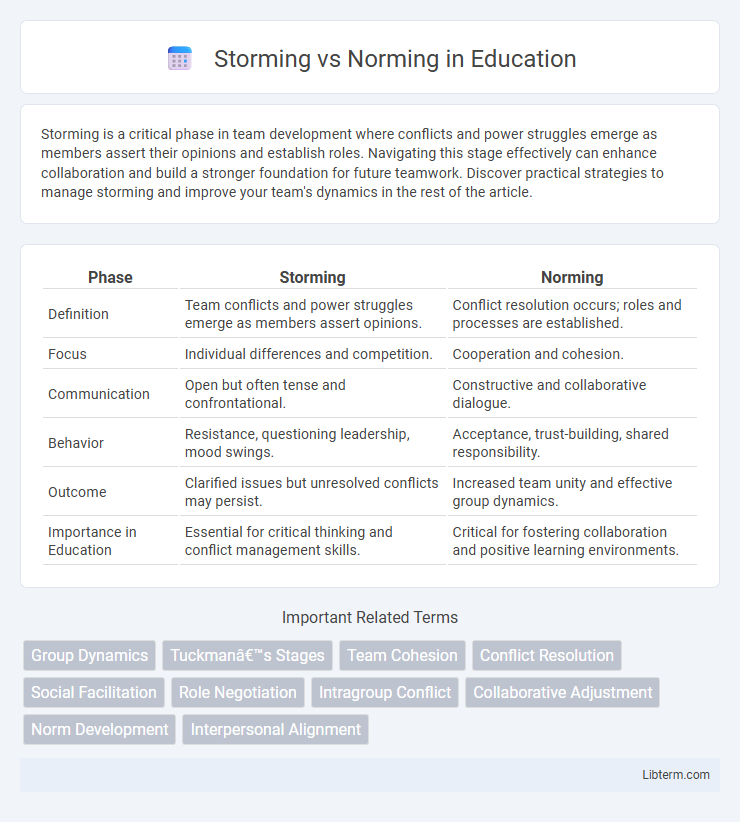Storming is a critical phase in team development where conflicts and power struggles emerge as members assert their opinions and establish roles. Navigating this stage effectively can enhance collaboration and build a stronger foundation for future teamwork. Discover practical strategies to manage storming and improve your team's dynamics in the rest of the article.
Table of Comparison
| Phase | Storming | Norming |
|---|---|---|
| Definition | Team conflicts and power struggles emerge as members assert opinions. | Conflict resolution occurs; roles and processes are established. |
| Focus | Individual differences and competition. | Cooperation and cohesion. |
| Communication | Open but often tense and confrontational. | Constructive and collaborative dialogue. |
| Behavior | Resistance, questioning leadership, mood swings. | Acceptance, trust-building, shared responsibility. |
| Outcome | Clarified issues but unresolved conflicts may persist. | Increased team unity and effective group dynamics. |
| Importance in Education | Essential for critical thinking and conflict management skills. | Critical for fostering collaboration and positive learning environments. |
Understanding Storming and Norming Stages
Storming and Norming are critical stages in group development that influence team dynamics and productivity. The Storming stage involves conflict and competition as team members assert their ideas and challenge each other, which is essential for addressing differences and fostering growth. During the Norming stage, the team establishes cohesion, develops shared norms, and improves collaboration, leading to a more unified and effective group performance.
Key Characteristics of Storming
Storming is characterized by conflict, competition, and power struggles as team members challenge each other's ideas and roles, leading to tension and resistance. Communication during this phase is often confrontational, with individuals asserting their opinions and testing boundaries to establish their positions within the group. Key behaviors include emotional responses, clashing personalities, and a struggle for control, which are critical for resolving differences and progressing toward team cohesion.
Defining the Norming Phase
The norming phase in team development establishes shared standards, roles, and mutual trust that foster collaboration and cohesion. During norming, team members resolve conflicts from the storming phase and agree on processes, enhancing communication and productivity. This stage solidifies group identity, enabling efficient task execution and collective problem-solving.
Team Dynamics During Storming
During the Storming phase of team development, conflicts emerge as members express differing opinions and challenge leadership, which is crucial for establishing roles and responsibilities. This stage tests team cohesion and communication patterns, requiring effective conflict resolution to prevent dysfunction. Understanding emotional reactions and facilitating open dialogue can transform tensions into collaborative problem-solving, setting the foundation for the Norming phase.
Transitioning from Storming to Norming
Transitioning from the Storming to Norming stage involves resolving conflicts and establishing clearer roles within the team, fostering trust and cooperation. Communication patterns shift from confrontation to collaboration, enabling the team to align on shared goals and develop effective problem-solving strategies. This phase enhances group cohesion as members prioritize collective success over individual differences, paving the way for higher productivity and stability.
Common Challenges in Each Stage
Storming stage often involves conflicts over roles, power struggles, and resistance to control, leading to misunderstandings and decreased productivity. Norming stage faces challenges in establishing effective communication patterns, gaining consensus on group norms, and overcoming lingering tensions from the previous stage. Addressing these challenges requires clear leadership, open dialogue, and building trust to facilitate smooth team development and collaboration.
Effective Leadership Strategies
Effective leadership strategies during the Storming stage involve active conflict resolution, clear communication, and fostering trust to navigate team disagreements and power struggles. In the Norming phase, leaders should emphasize collaboration, reinforce shared goals, and promote accountability to solidify team cohesion and enhance productivity. Leveraging emotional intelligence and adaptive leadership styles supports smooth transitions between these stages, optimizing overall team performance.
Communication Techniques for Growth
Storming and Norming are critical phases in team development where effective communication techniques drive progress; during Storming, open dialogue and active listening help address conflicts and clarify team roles, fostering mutual understanding. In the Norming stage, consistent feedback loops and supportive communication establish trust and collaboration, enabling the team to develop shared goals and norms. Utilizing techniques like structured check-ins and conflict resolution strategies accelerates growth by promoting transparency and accountability.
Measuring Team Progress
Storming and Norming stages in team development show distinct patterns for measuring team progress through conflict resolution metrics and collaboration efficiency indicators. During the Storming phase, progress is measured by tracking the decrease in interpersonal conflicts and the improvement in open communication, while in the Norming phase, assessment focuses on the consistency of cooperative behavior and adherence to team norms. Quantitative tools like team cohesion surveys and task completion rates provide valuable data to evaluate the transition from Storming to Norming.
Tips for Accelerating Team Development
Accelerate team development by fostering open communication and trust during the Storming phase to quickly resolve conflicts and clarify roles. Emphasize active listening and encourage collaboration to smoothly transition into the Norming stage where shared goals and mutual respect strengthen cohesion. Implement regular feedback sessions and celebrate small wins to maintain momentum and reinforce positive group dynamics.
Storming Infographic

 libterm.com
libterm.com